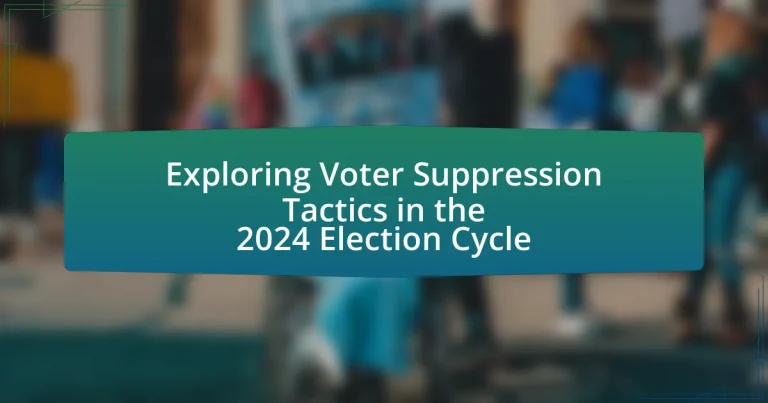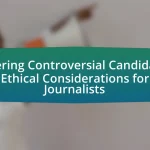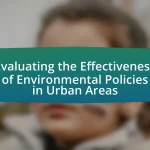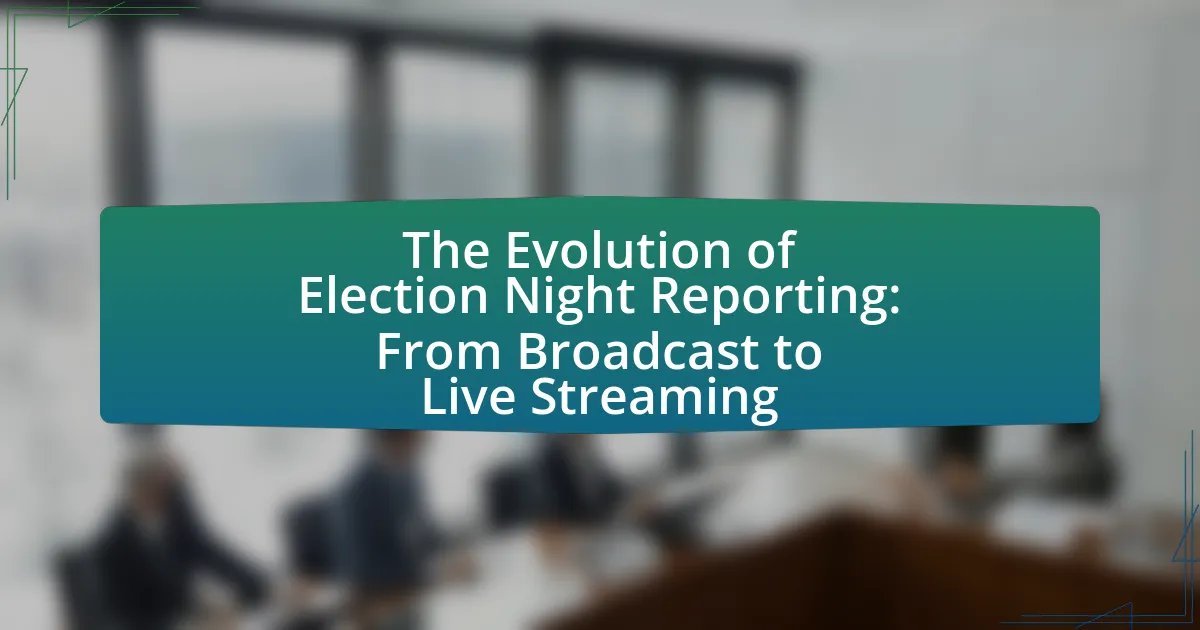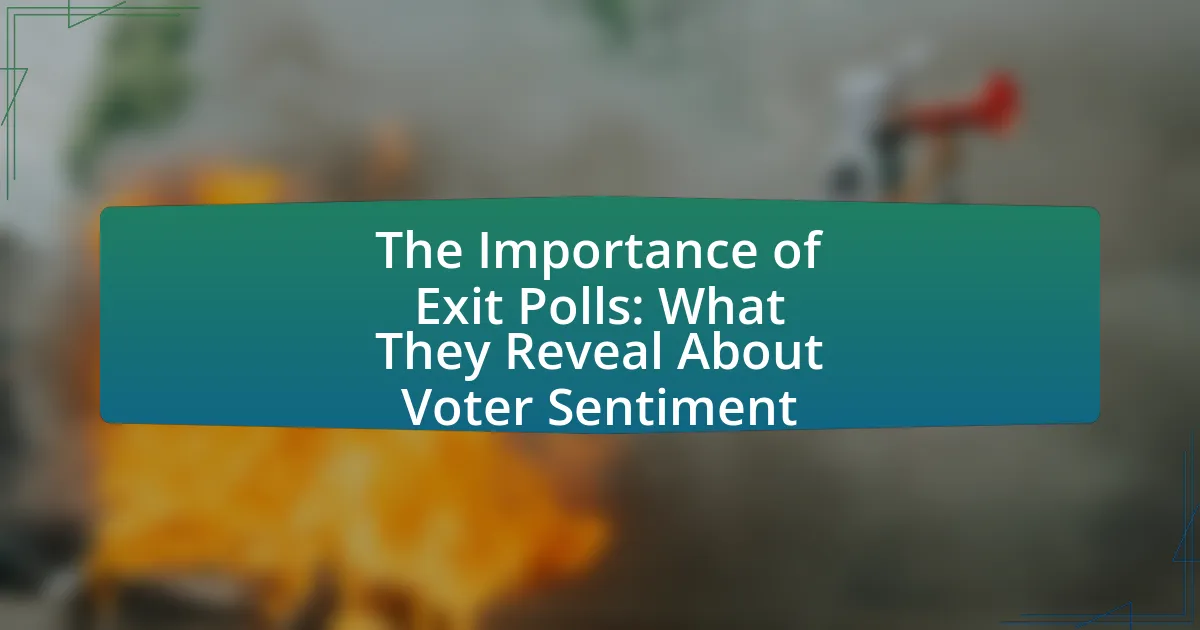The article examines key voter suppression tactics observed in the 2024 election cycle, including strict voter ID laws, purging of voter rolls, reduction of polling places, and limitations on mail-in voting options. It highlights the impact of these tactics on voter turnout, particularly among marginalized communities such as racial minorities, low-income individuals, and young voters. The article also discusses the historical context of voter suppression, legal precedents, and the motivations behind these tactics, as well as the responses from advocacy groups and legal actions aimed at combating voter suppression. Additionally, it provides resources for voters to protect themselves and report instances of suppression.
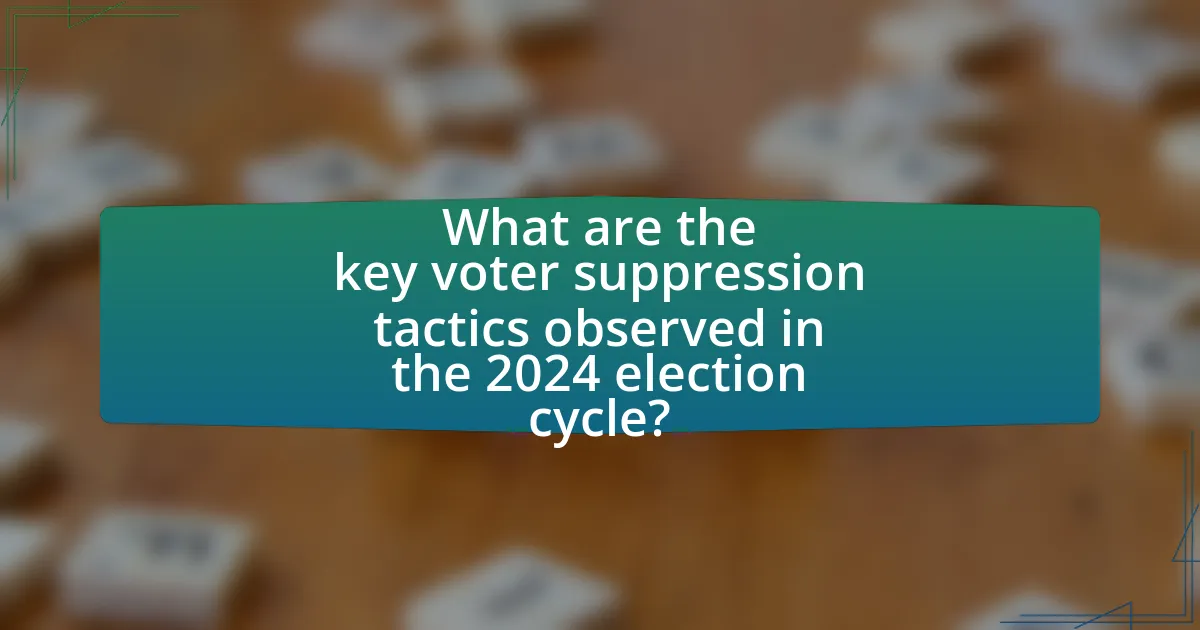
What are the key voter suppression tactics observed in the 2024 election cycle?
Key voter suppression tactics observed in the 2024 election cycle include strict voter ID laws, purging of voter rolls, reduction of polling places, and limiting mail-in voting options. Strict voter ID laws require specific forms of identification that may not be accessible to all voters, disproportionately affecting marginalized communities. The purging of voter rolls often removes eligible voters, sometimes without adequate notification, leading to confusion and disenfranchisement. The reduction of polling places, particularly in urban areas, results in long lines and increased wait times, discouraging participation. Lastly, limiting mail-in voting options, such as reducing the number of drop boxes or imposing strict deadlines, further complicates the voting process for those unable to vote in person. These tactics collectively contribute to a significant barrier for many voters, undermining the democratic process.
How do these tactics impact voter turnout?
Voter suppression tactics significantly decrease voter turnout by creating barriers that discourage or prevent individuals from casting their votes. For instance, strict voter ID laws can disproportionately affect minority and low-income voters, leading to a reduction in their participation rates. Research from the Brennan Center for Justice indicates that states with strict voter ID laws saw a decrease in turnout by as much as 2-3% among eligible voters. Additionally, tactics such as purging voter rolls and limiting polling places can create confusion and accessibility issues, further diminishing turnout. A study by the U.S. Government Accountability Office found that voters in areas with fewer polling places experienced longer wait times, which can lead to frustration and ultimately lower participation.
What demographic groups are most affected by these tactics?
The demographic groups most affected by voter suppression tactics include racial minorities, low-income individuals, and young voters. Racial minorities, particularly African Americans and Hispanics, face barriers such as strict voter ID laws and reduced polling places, which disproportionately impact their ability to vote. According to the Brennan Center for Justice, states with strict voter ID laws saw a significant drop in turnout among these groups in previous elections. Low-income individuals often struggle with access to transportation and time off work, further hindering their voting participation. Additionally, young voters, who frequently encounter obstacles like registration deadlines and misinformation, are also significantly affected, as evidenced by lower turnout rates in elections where such tactics are employed.
How do these tactics vary by state or region?
Voter suppression tactics vary significantly by state and region, influenced by local laws, demographics, and political climates. For example, states like Georgia and Texas have implemented strict voter ID laws and reduced early voting hours, which disproportionately affect minority voters. In contrast, states such as California have expanded access through measures like automatic voter registration and mail-in voting. Research from the Brennan Center for Justice indicates that states with Republican leadership tend to adopt more restrictive voting measures, while Democratic-led states often pursue policies that enhance voter access. This regional disparity highlights how local governance shapes the effectiveness and nature of voter suppression tactics.
What historical context is important for understanding voter suppression?
Understanding voter suppression requires examining the historical context of discriminatory practices aimed at limiting access to the ballot. Key events include the post-Civil War implementation of Jim Crow laws, which enforced racial segregation and disenfranchised Black voters through literacy tests and poll taxes. The Voting Rights Act of 1965 aimed to eliminate such barriers, yet subsequent Supreme Court decisions, such as Shelby County v. Holder in 2013, weakened federal oversight, leading to a resurgence of voter suppression tactics. These historical developments illustrate the ongoing struggle against systemic barriers to voting, particularly for marginalized communities.
How have past elections influenced current voter suppression tactics?
Past elections have significantly shaped current voter suppression tactics by establishing methods that target specific demographics and exploit legal loopholes. For example, the 2013 Supreme Court decision in Shelby County v. Holder weakened the Voting Rights Act, leading to a surge in state-level laws that impose strict voter ID requirements and reduce early voting opportunities, particularly affecting minority communities. Additionally, the 2020 election saw an increase in misinformation campaigns aimed at dissuading voters from participating, a tactic that has persisted into the current election cycle. These historical precedents demonstrate how past electoral outcomes and judicial rulings have directly influenced the strategies employed to suppress voter turnout today.
What legal precedents exist regarding voter suppression?
Legal precedents regarding voter suppression include cases such as Shelby County v. Holder (2013), where the Supreme Court invalidated key provisions of the Voting Rights Act, effectively weakening federal oversight of state voting laws. This decision led to a rise in state-level laws perceived as suppressive, such as voter ID requirements and purging voter rolls. Another significant case is Brnovich v. Democratic National Committee (2021), where the Supreme Court upheld Arizona’s voting restrictions, ruling that they did not violate the Voting Rights Act, further establishing a legal framework that allows states to implement measures that can disproportionately affect minority voters. These cases illustrate the evolving legal landscape surrounding voter suppression and its implications for electoral access.
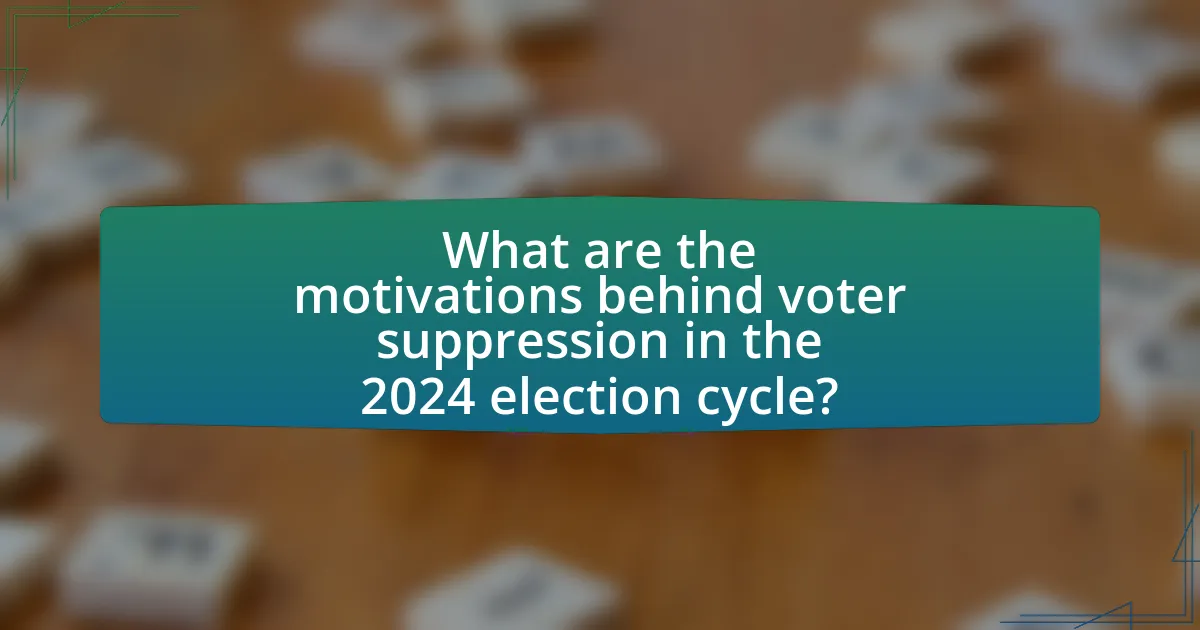
What are the motivations behind voter suppression in the 2024 election cycle?
The motivations behind voter suppression in the 2024 election cycle primarily include the desire to maintain political power and influence electoral outcomes. Political parties and groups may implement restrictive voting laws, such as voter ID requirements and purging voter rolls, to target demographics that typically vote for their opponents. For instance, studies have shown that such tactics disproportionately affect minority communities, which tend to lean Democratic. Additionally, the rise of misinformation campaigns aims to create confusion and distrust in the electoral process, further discouraging voter participation. These strategies are often justified by claims of preventing voter fraud, despite evidence indicating that such fraud is exceedingly rare in the United States.
How do political parties utilize voter suppression tactics?
Political parties utilize voter suppression tactics by implementing measures that restrict access to voting for specific demographics. These tactics include stringent voter ID laws, purging voter rolls, reducing polling places in targeted areas, and limiting early voting opportunities. For instance, states like Georgia and Texas have enacted laws that require voters to present specific forms of identification, disproportionately affecting minority groups who may lack these IDs. Additionally, studies have shown that reducing the number of polling places in urban areas leads to long lines and increased wait times, discouraging voters from participating. These strategies are often justified under the guise of preventing voter fraud, despite evidence indicating that such fraud is exceedingly rare.
What strategies do parties employ to justify these tactics?
Parties employ strategies such as framing voter suppression tactics as necessary for election integrity to justify their actions. By emphasizing the need to prevent voter fraud, which studies show is exceedingly rare, parties create a narrative that positions these tactics as protective measures. For instance, in various states, legislation has been introduced that restricts voting access under the guise of safeguarding elections, despite evidence from organizations like the Brennan Center for Justice indicating that such fraud is virtually non-existent. This framing allows parties to rally support among constituents who may fear electoral misconduct, thereby legitimizing their suppression tactics.
How does voter suppression align with broader political goals?
Voter suppression aligns with broader political goals by enabling certain political parties to maintain or gain power by limiting the electoral participation of specific demographic groups. This tactic often targets minorities, young voters, and low-income individuals, who tend to favor opposing political ideologies. For instance, laws that impose strict voter ID requirements or reduce polling places in predominantly minority neighborhoods can significantly decrease voter turnout among these groups, thereby skewing election outcomes in favor of the suppressing party. Historical evidence shows that states implementing such measures often experience a drop in voter participation, which correlates with electoral victories for the party advocating these suppressive tactics.
What role does misinformation play in voter suppression?
Misinformation significantly contributes to voter suppression by creating confusion and distrust among potential voters. This confusion can lead to decreased voter turnout, as individuals may be misled about voting procedures, eligibility requirements, or the importance of their vote. For instance, during the 2020 U.S. elections, false claims about mail-in voting and voter fraud circulated widely, which resulted in many eligible voters feeling discouraged from participating. Research from the Brennan Center for Justice indicates that misinformation can disproportionately affect marginalized communities, further exacerbating existing inequalities in voter participation.
How is misinformation disseminated during the election cycle?
Misinformation is disseminated during the election cycle primarily through social media platforms, where false narratives can spread rapidly among users. Research indicates that misinformation can reach millions of individuals within hours, significantly influencing public perception and voter behavior. For instance, a study by the Pew Research Center found that 64% of Americans believe fabricated news stories cause confusion about the basic facts of current events, particularly during elections. Additionally, bots and fake accounts amplify misleading content, creating an illusion of consensus around false information. This manipulation of information undermines the electoral process and can lead to voter suppression by creating distrust in legitimate sources and processes.
What are the effects of misinformation on voter perception and behavior?
Misinformation significantly distorts voter perception and behavior by creating confusion and distrust in the electoral process. Studies indicate that exposure to false information can lead to decreased voter turnout, as individuals may feel disillusioned or uncertain about the legitimacy of their vote. For instance, a 2020 study published in the journal “Political Behavior” found that misinformation about voting procedures led to a 5% decrease in turnout among affected demographics. Additionally, misinformation can reinforce existing biases, causing voters to align more closely with misleading narratives that confirm their preconceptions, thereby polarizing the electorate. This manipulation of perception ultimately undermines the democratic process by skewing public opinion and influencing electoral outcomes.
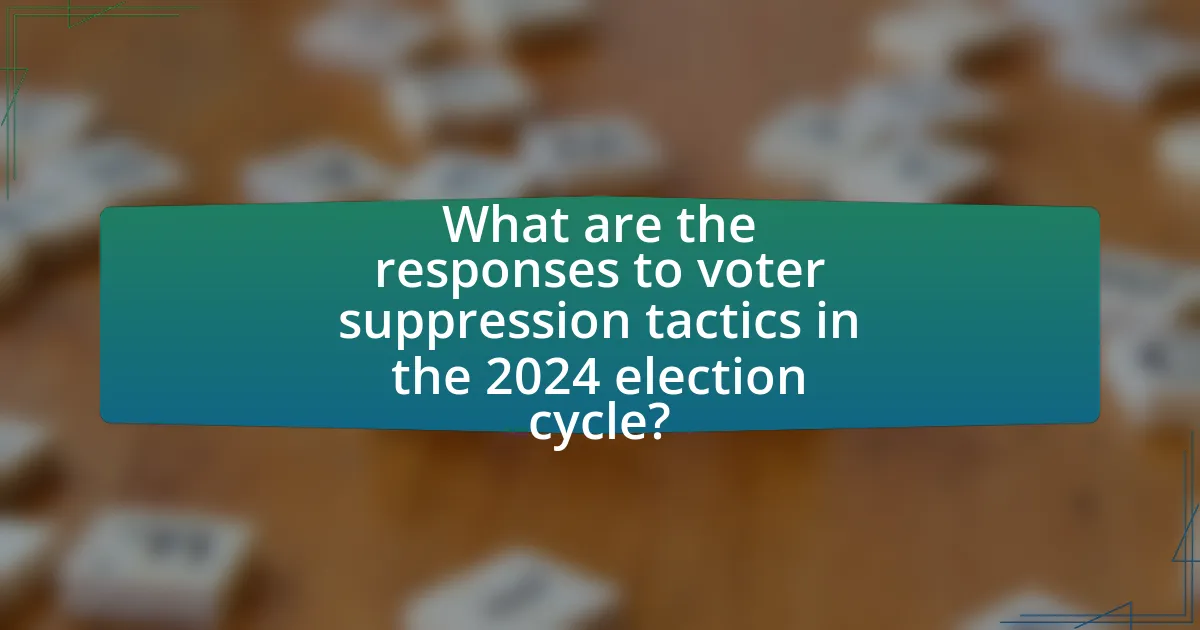
What are the responses to voter suppression tactics in the 2024 election cycle?
Responses to voter suppression tactics in the 2024 election cycle include legislative measures, grassroots mobilization, and legal challenges. Various states have introduced bills aimed at expanding access to voting, such as automatic voter registration and extended early voting periods, in direct response to restrictive laws. Grassroots organizations are actively working to educate voters about their rights and mobilize communities to participate in elections, countering suppression efforts. Additionally, numerous lawsuits have been filed against states implementing voter ID laws and other restrictive measures, arguing that these tactics disproportionately affect marginalized groups. For instance, the NAACP and the ACLU have been involved in legal actions to protect voting rights, highlighting the ongoing struggle against voter suppression.
How are advocacy groups working to combat voter suppression?
Advocacy groups are combating voter suppression by implementing legal challenges, conducting voter education campaigns, and mobilizing grassroots efforts. These organizations, such as the American Civil Liberties Union (ACLU) and the NAACP, actively file lawsuits against restrictive voting laws, aiming to protect voting rights as seen in cases like Shelby County v. Holder, which highlighted the need for federal oversight in states with a history of discrimination. Additionally, they provide resources and information to educate voters about their rights and the voting process, addressing misinformation and barriers that may deter participation. Grassroots mobilization efforts, including door-to-door canvassing and phone banking, are also employed to encourage voter registration and turnout, particularly in marginalized communities disproportionately affected by voter suppression tactics.
What specific initiatives have been launched to protect voter rights?
Specific initiatives launched to protect voter rights include the introduction of automatic voter registration, expansion of early voting, and the implementation of measures to enhance accessibility for individuals with disabilities. For instance, several states have enacted laws to automatically register eligible citizens when they interact with state agencies, which has increased voter participation rates. Additionally, the expansion of early voting days and locations has been shown to reduce long lines and wait times, making it easier for voters to cast their ballots. Furthermore, initiatives aimed at improving polling place accessibility, such as providing resources for individuals with disabilities, have been implemented to ensure that all citizens can exercise their right to vote without barriers.
How effective have these initiatives been in previous elections?
These initiatives have shown varying levels of effectiveness in previous elections, often resulting in reduced voter turnout among targeted demographics. For instance, studies indicate that voter ID laws implemented in several states led to a decrease in participation rates, particularly among minority and low-income voters. A 2014 study by the Government Accountability Office found that states with strict voter ID laws experienced a 2-3% drop in turnout compared to those without such laws. Additionally, research from the Brennan Center for Justice highlights that purging voter rolls disproportionately affects minority communities, further illustrating the impact of these tactics on electoral participation.
What legal actions are being taken against voter suppression?
Legal actions against voter suppression include lawsuits filed by various organizations and state officials aimed at challenging restrictive voting laws. For instance, the NAACP and the ACLU have initiated legal proceedings in multiple states, arguing that laws such as voter ID requirements and purging voter rolls disproportionately affect minority communities. In 2021, the U.S. Department of Justice also announced its intention to monitor and challenge state laws perceived as suppressive, citing the Voting Rights Act as a basis for these actions. These legal efforts are designed to protect voting rights and ensure equitable access to the electoral process.
What recent lawsuits have been filed regarding voter suppression tactics?
Recent lawsuits regarding voter suppression tactics include actions taken by various civil rights organizations against states implementing restrictive voting laws. For instance, in 2023, the NAACP and the ACLU filed lawsuits against Georgia’s voting law, which they argue disproportionately affects minority voters by imposing stricter ID requirements and limiting access to drop boxes. Additionally, in Arizona, a coalition of advocacy groups challenged new laws that they claim suppress voter turnout by reducing early voting opportunities and increasing penalties for ballot collection. These lawsuits aim to protect voting rights and ensure equitable access to the electoral process.
How do these legal actions impact the electoral process?
Legal actions significantly impact the electoral process by shaping the rules and regulations governing elections. For instance, lawsuits challenging voter ID laws or gerrymandering can lead to changes in voting procedures, potentially increasing or decreasing voter turnout. Historical examples include the Supreme Court’s decision in Shelby County v. Holder (2013), which invalidated key provisions of the Voting Rights Act, resulting in several states implementing stricter voting laws that disproportionately affected minority voters. Such legal actions can create barriers to voting, thereby influencing election outcomes and the overall democratic process.
What can voters do to protect themselves from voter suppression?
Voters can protect themselves from voter suppression by educating themselves about their voting rights and the specific laws in their state. Understanding the registration process, polling locations, and identification requirements is crucial, as many states have enacted laws that can create barriers to voting. For instance, the Brennan Center for Justice reports that over 400 bills aimed at restricting voting access were introduced in 2021 alone, highlighting the need for vigilance. Additionally, voters should ensure they are registered well in advance of elections and verify their registration status, as errors or purges can occur. Engaging with local advocacy groups can also provide resources and support to navigate potential challenges at the polls.
What resources are available for voters to verify their registration status?
Voters can verify their registration status through several resources, including state election office websites, the National Association of Secretaries of State website, and the U.S. Vote Foundation. Each state maintains its own online portal where voters can check their registration status by entering personal information such as name, date of birth, and sometimes driver’s license number. The National Association of Secretaries of State provides a directory of state election websites, ensuring voters can easily access their specific state’s resources. The U.S. Vote Foundation offers a comprehensive platform that guides voters through the verification process and provides additional information on voting procedures. These resources are essential for ensuring that voters are aware of their registration status ahead of elections, particularly in the context of potential voter suppression tactics.
How can voters report instances of voter suppression?
Voters can report instances of voter suppression by contacting local election officials, state election offices, or organizations dedicated to voting rights, such as the Election Protection Hotline at 1-866-OUR-VOTE. Reporting can include providing details about specific incidents, such as intimidation at polling places or misinformation about voting procedures. According to the National Association of Secretaries of State, these channels are established to ensure that voter suppression is documented and addressed effectively.
